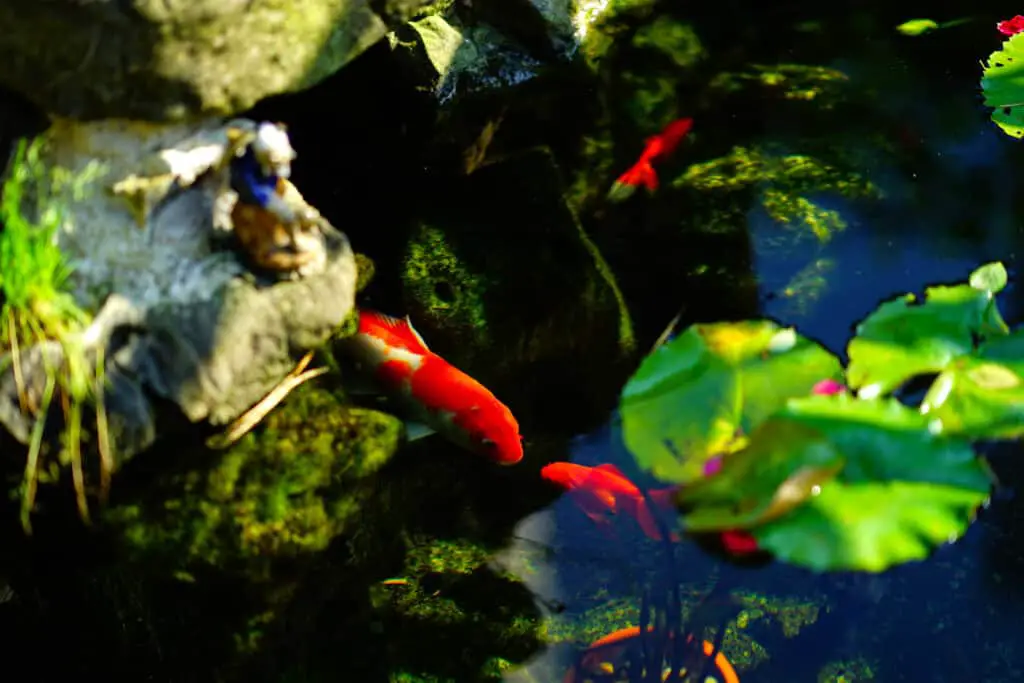
Koi fish are exquisite additions to your outdoor pond. These beautiful fish are a favorite amongst pond lovers for their assortment of colors. Although, buying koi fish can become costly if you want to grow your pond. Breeding is the better option! However, watch out for the adult Koi and those tiny koi babies – there is not much parental love there!
Koi fish will eat their babies. Koi fish do not eat their babies out of aggression but due to confusion as they mistake the small fry for insects or other types of food. Therefore, removing the koi eggs and placing them in a separate tank for hatching and maturing is best.
If you want to grow your Koi population but do not feel like spending money on more fish, then it’s time to start breeding! Breeding and taking care of koi fry is easier than you may think! However, an adult koi is a natural predator for your baby fry. Read on and find out what you need to know about Koi breeding, hatching, and keeping those tiny fish safe!
Pro Tip: If you’re tired of wasting money and making costly mistakes on the koi-keeping hobby or are thinking about buying koi fish but don’t know where to start, I strongly suggest you check out this ebook. I recently read this ebook, and it contains SO much useful information, such as:
- 3 proven steps to identify koi fish diseases
- WARNING: 3 things you should NEVER do when it comes to caring for koi
- When to seek professional help when it comes to looking after your koi
Will Koi Eat Their Babies?

Koi fish will eat their babies. These fish are omnivores and thus don’t only eat plant matter but also insects, worms, and other living creatures.
If you would like to learn more about what insects koi fish will eat in their pond, you can read my blog posts here: Do koi fish eat mosquito larvae? and Worms: should koi eat them?
When koi fish hatch, the fry is around the size of an eyelash – only a few millimeters in length. The adult koi fish, in comparison, is relatively large. This often leads to koi fish mistaking these tiny little fish for other sorts of food; thus, they most often get eaten.
Koi babies often hide in nooks and crevices or between plants to prevent getting gobbled up by the much larger koi. Therefore, only a select few koi fry make it to adulthood – if they can hide out and avoid being eaten for long enough.
Due to this, koi breeders will inform you that the best decision you can make is to keep your koi fry away from the adults for as long as possible if you want them to mature. If they are not separated from the adults, you will most likely see only one or two (if you’re lucky) grow to become adults.
As your koi fry grows, you may wonder if they have grown big enough not to get eaten by the larger koi fish; if so, you can read my blog post: Will large koi eat smaller koi fish?
How Many Babies Do Koi Have At Once?
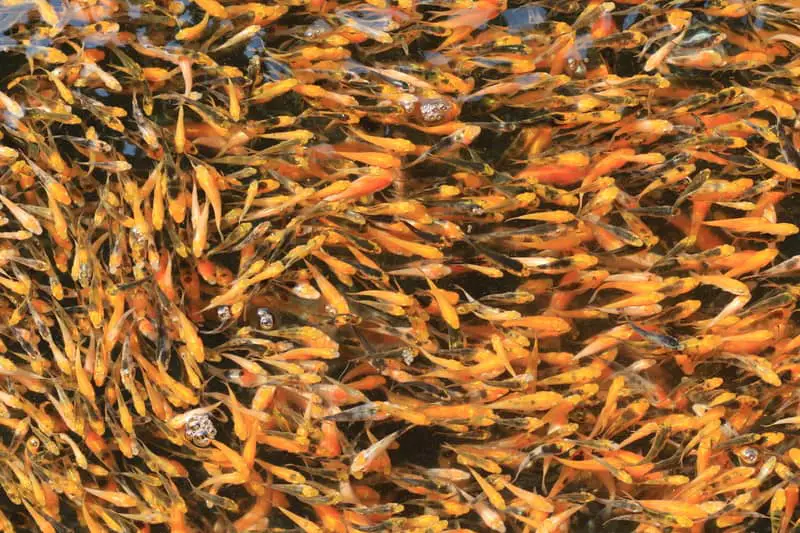
Koi fish will lay around 100 000 eggs for every kilogram of weight. This means that if not one single egg or fry gets eaten, there can be about 100 000 baby koi born in one go!
However, it is highly unlikely, almost impossible, that all 100 000 will hatch and mature to adulthood. In the wild, koi fry has a very low survival rate. Firstly, a large majority of the eggs will be eaten by predators before even having a chance to hatch. Next, the small fry is commonly eaten by other larger fish and aquatic life.
This is why the koi fish lay so many eggs – the chance of even a few maturing is low. Ensuring many eggs are laid better increases the chances that a handful of the koi will grow and become breeding koi themselves.
Around 20 000 to 50 000 will most likely hatch in a pond. So you can expect a lot of koi fry around your pond!
How To Prevent Koi Fry From Being Eaten
If you have some koi fish and want to add a few more to your pond without buying new ones, it’s good to learn the best way to ensure your baby koi survive!
The most common method is removing your mating koi from your pond and allowing for spawning in a separate pond. Once the koi has laid the eggs, you can place the adult koi back into the original pond.
Many breeders recommend that once the mother has laid her eggs, she be placed in her own separate tank for a little while before returning to the main tank. This is so she may recuperate after the egg-laying process, as this can be tiring.
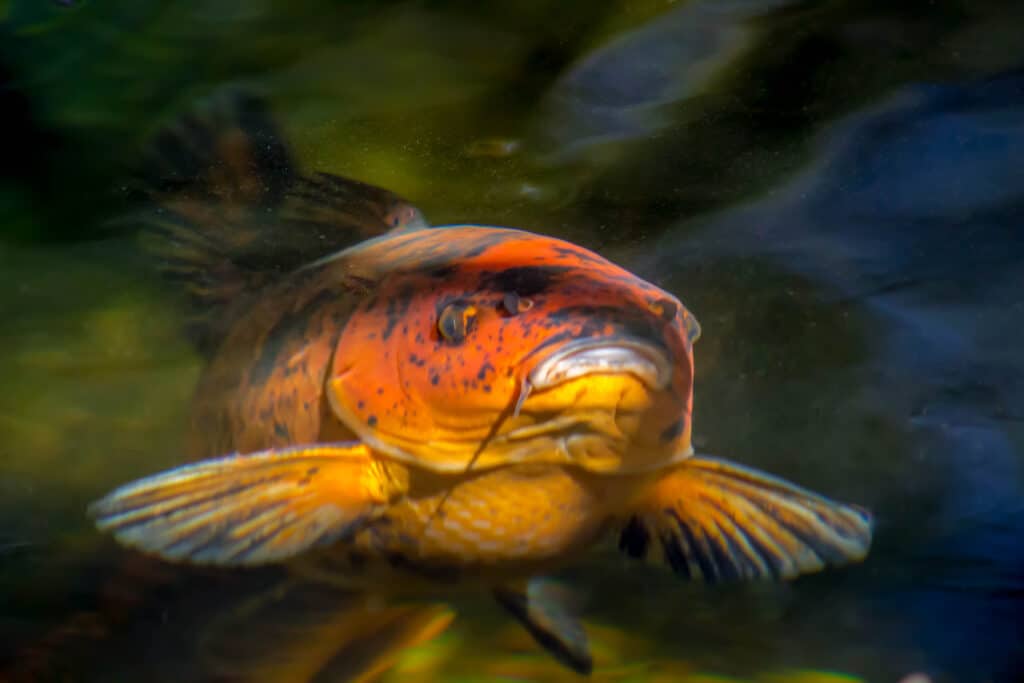
How To Take Care of Koi Fry
Once your eggs are in a separate tank, the best thing to do is to watch the koi eggs closely over the next four days. This is how long it takes for koi to hatch, so keep checking throughout the days until you see signs of life.
It is best to keep the fry tank relatively simple, so you may easily see what is going on. Too many plants will crowd the tank, making monitoring the fry harder.
Once the eggs have hatched, you should notice that the tiny fry has a yolk sac attached to them. This is what will feed them for the next day or so; therefore, you won’t have to worry about food initially. After a day or two, the babies will start to swim around, and you may notice if you look hard enough that their mouth has developed and other essential organs.
When koi fry hatch, they often attach to plants, so having a few plants is essential for the fry. Once they have secured themselves to the plants, they will use them as a guide to swim up to the surface and fill their swim bladder with air. This will allow them to swim, as swim bladders are necessary for buoyancy.
Koi fry will continue to grow over the months. The exact time they can be placed back into the main pond is always tricky as it depends on the size of the other koi. A rule of thumb is that you can introduce your koi fry into the main pond when they have reached 3 inches in length.
However, I would advise you to consider the size of your adult koi fish mouth and determine if the babies can fit inside. The adult koi will eat anything small enough to fit inside its mouth!
Do not rush to get them back into the main pond. Wait until you are absolutely certain they are too big to be eaten!
What Should I Feed Koi Fry?
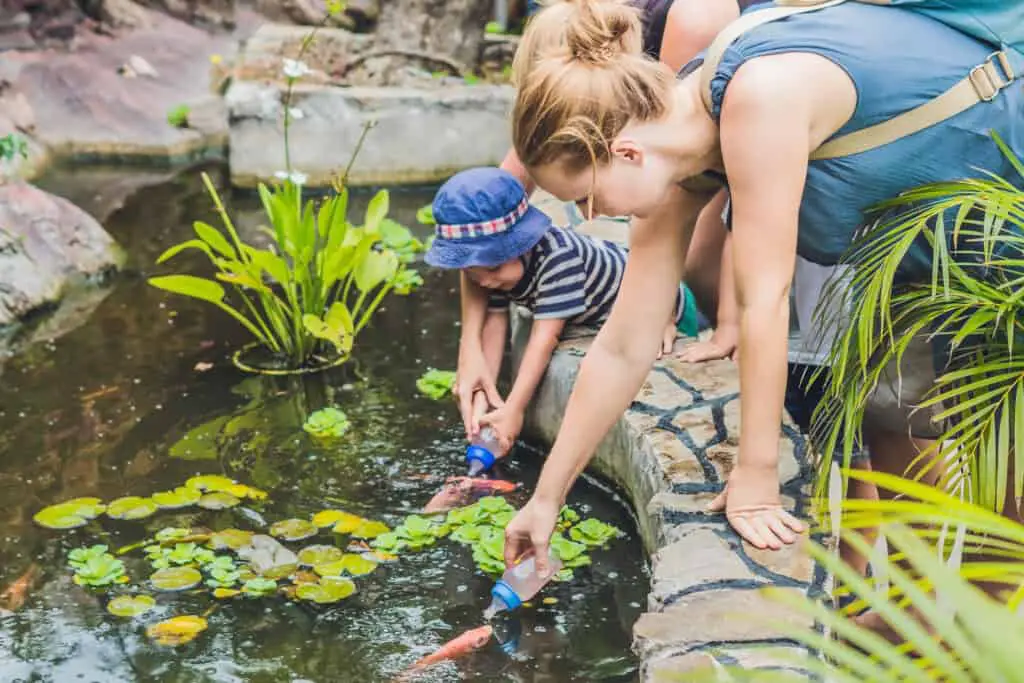
There are various options for feeding koi fry. Overall, you should feed the fry around four or five times a day for about a week after hatching.
The most common method is buying commercial food from any local pet store. This is simple, easy, and stress-free for a beginner koi breeder. Another option is to purchase liquid food options.
It is good to vary their diet and not stick to purely one method. This is important so that the babies obtain their nutrients. Once the two-week mark has passed, you can move on to feeding them store-bought fish flakes.
While there are commercial methods, there are a few home feeding methods that more comfortable breeders may use for the first two weeks after hatching:
- Powdered Adult Koi Food
- Egg Paste
Koi Fry Food: Powdered Adult Koi Food
If you do not feel like buying a new food source for your koi, a good option is to use what you currently have in your house: adult koi food!
The adult koi food is too large for the babies to eat, but a common technique is to throw the food into a blender and grind it up into a powder. It is important that it does not have large clumps and is a complete powdered texture; otherwise, your fry will not be able to ingest it.
Koi Fry Food: Egg Paste
An egg paste is a popular method for feeding baby koi after hatching. This meal is protein-rich – vitally important for the initial days of growth!
You will need two ingredients for this:
- Purified Water
- Three eggs: hard-boiled
The equipment needed is a fork, a cup, and a plastic squirt bottle to get the solution into the tank.
Step 1: Remove the yellow yolk from the egg. Throw away (or eat) the white of the egg.
Step 2: Place the three egg yolks in your cup and mash them until they become a paste.
Step 3: Next, add the water to the cup. You can add half a cup of water for each egg yolk. Therefore, you will add one and a half cups of water in this case. Give this a good mix until the egg is dissolved into the water.
Step 4: Take your plastic squirt bottle, suck up some of the solution, and squirt a small amount on the water’s surface.
Be careful not to put too much egg paste in your pond, as this will mess with the pond’s climate. Instead, place a tiny bit on the surface and note how much is eaten by the fry. You can repeat this amount every time and increase it if needed. You do not want uneaten egg paste floating around.
What Else Will Eat My Koi Babies?
A relativity unknown but vitally important fact is that koi fry grows at different rates. Although, there is a particular type of fry you need to look out for: Tobi Koi Fry!
A Tobi Koi Fry is a larger koi fry than the other babies. This type of fry will grow much faster than the others. They are usually quicker swimmers and are much stronger than the rest. Due to their name, it is commonly thought that they are a different type of koi but let me assure you, they aren’t.
These koi may seem harmless, but they can act just like the adult koi and will eat the other smaller fry. Do not underestimate these little guys. They can wipe out an entire set of koi fry if not dealt with!
It is, therefore, crucial to remove any Tobi Koi fry and place them in a separate tank. Once they reach a size safe enough not to be eaten, you may put them into the main pond.
Another important creature to look out for are the Dragonfly Nymphs. Dragonfly nymphs are Dragonfly larvae and are known predators of koi fry. It is common for a Dragonfly to lay her eggs in a pond, and when they hatch, out pop these Dragonfly nymphs. These can become a serious problem and will feed on your koi fry as they grow.
It is best to remove them and place them in another body of water if you do not want to kill them.
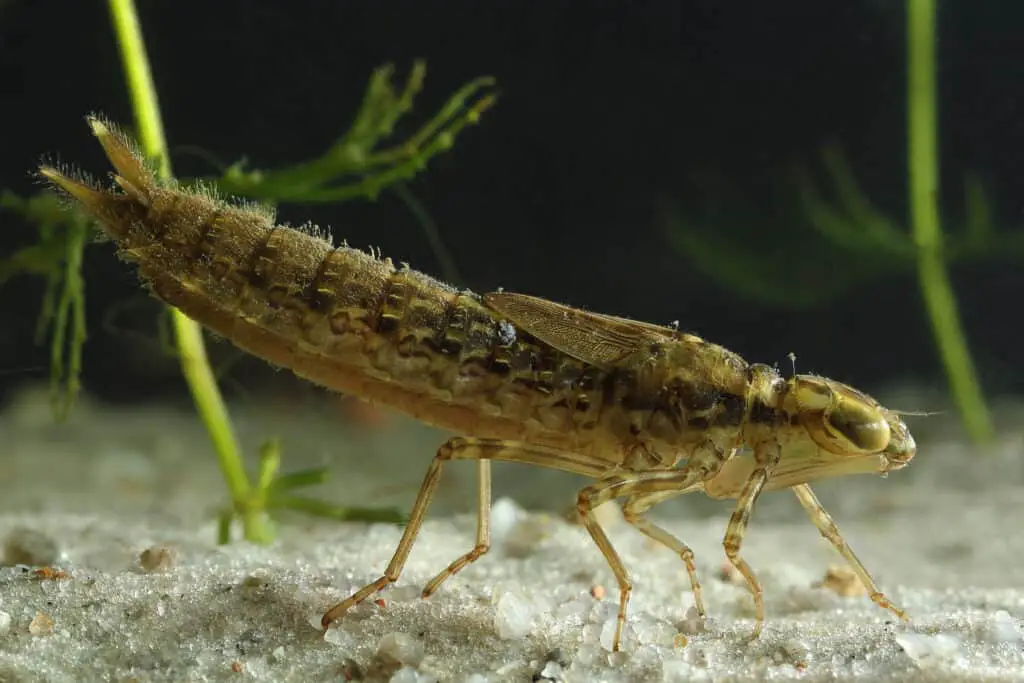
How Often Do Koi Fish Lay Eggs?
A koi fish will lay eggs at least once a year. Once a female koi has matured, around two years of age, she can lay eggs annually.
The laying of the eggs usually happens in the springtime – between late March and June. If you want your female koi to lay eggs that year, you must keep your pond climate ideal for breeding. Any conditions that are not optimal will prevent the female from laying eggs.
Ensure that you have a temperature gauge to keep the water between 59 and 77-degree Fahrenheit. It is also important that your pond has varying depth levels. Shallower and deeper areas allow your koi to seek cooler or warmer areas depending on their needs.
Lastly, the Koi pond should remain very slightly alkaline. Try to maintain the pH levels of the pond of around 7 to 8.6, with the ideal pH of 7.5. You can test the pH of the pond with a pH strip you can buy from the shop.
If the pond is too alkaline or too acidic, you must treat the water to make the conditions ideal for breeding.
Conclusion
In conclusion, koi eat their babies as they confuse them for food. Koi can lay around 100 000 eggs; of these many eggs, about 20 000 to 50 000 can hatch. It is best to remove a female koi and place her in a separate pond for spawning, as it will be impossible to try to collect all the eggs!
Once the babies have hatched, you can feed them store-bought fry food or make an egg paste mix! When these little guys reach around 3 inches in length, you may introduce them into your main koi pond. Look out for Tobi Koi Fry and Dragonfly Nymphs, as these will gobble up the tiny fry!
References
https://animals.mom.com/how-to-raise-baby-koi-after-they-are-born-12522532.html
https://www.animalpicturesarchive.com/do-koi-fish-eat-their-babies/
https://pethelpful.com/fish-aquariums/Feeding-Suggestions-for-Baby-Koi-Newborn-to-Three-Months
https://animals.mom.com/raise-koi-eggs-7402.html
https://homeguides.sfgate.com/control-ph-levels-ponds-38626.html


